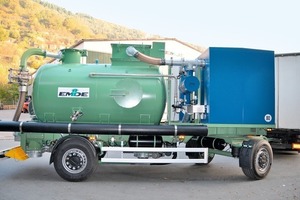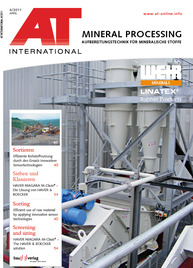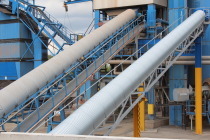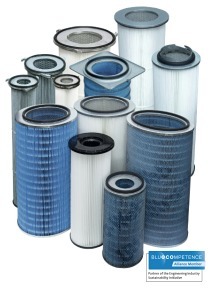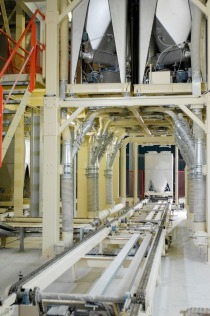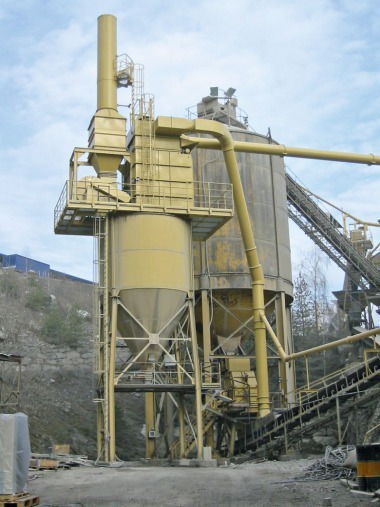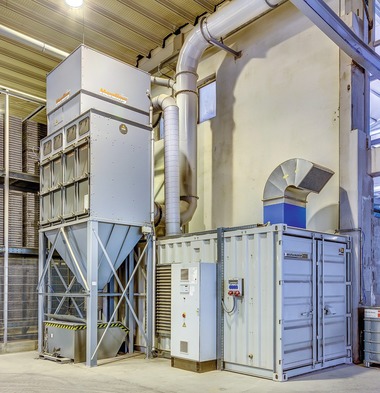Mobile extractor/blower system
Again and again, in atmospheres with explosive dust/air mixtures, the introduction of an ignition source leads to explosions, resulting in severe damage to equipment and even to the deaths of equipment operators. Constant cleaning is the only way to avoid such risks despite the presence of a potential source of ignition. Extraction of the dust is the only suitable and effective method of cleaning.
It is expedient to equip buildings and facilities with a central pipe network with a total length of several kilometres. With such networks, it is possible to extract dust from several points in the operation at the same time. The suction hose is connected to the central dust extraction network with a spring-loaded flap valve. Besides the extraction hose and the cleaning nozzle, the cleaning operatives do not have to drag anything around. At the cleaning points, neither power nor a compressed air connection is required. A pipe network can be extended at any time or installed in an existing building or facility. The dust extraction line consists of a galvanized steel pipe. The pipes are connected dust-tight with pressure-sealed clamps. The pipe bends are designed with large radii where possible and can, if required be supplied, with additional wear protection or a fusion-cast basalt lining. To ensure optimal air-borne conveying of the dust in the pipeline, conveying air intake valves are installed in the pipeline for automatic regulation of the air volume.
The central unit of a dust extraction system is the separator with filter system and the blower for generating underpressure. The filter separates the extracted product from the conveying air. The filter bags in the filter housing are cleaned cyclically with a pulse of compressed air. For protection of the filter elements and to avoid additional sources of ignition, a magnetic separator with extraction equipment is installed in the intake line The underpressure is generated by a rotary piston blower, monitored on the basis of differential pressure, which immediately switches off if the filter is punctured. The fully automated dust extractor is operated with an electric control system with a PLC. The operating states can be displayed on an operating panel built in the switch cabinet door. This is also used to operate the system.
For the safe disposal of the extracted dusts or for dust-free recirculation of the product into the material flow, EMDE supplies a closed system solution for discharge of the material from the filter via a flap valve as well as for subsequent wetting in a batch mixer or a continuously operating double-blade mixing screw. To add to its range, EMDE has a combined extractor/blower system (Fig.), with which the extracted dusts can be pneumatically discharged directly from the separator. This system was specially developed for the following application: in a power plant, the extracted filter ash fed back to the firing process. This reduces the disposal costs substantially and supposed “waste product” is given additional calorific value.
For input of the dust into the combustion chamber, the mobile extractor/blower system is connected to the combustion chamber with a hose. A horizontal discharge screw in the base of the separator doses the dust in a pneumatic feeder shoe. The geometric shape of the container and the appropriate dimensioning of the discharge screw guarantee the safe and reliable discharge of the dust. Emptying of the separator with a useful volume of around 3 m³ takes a maximum of 10 min.
This mobile unit also has its own compressed air generation with a piston compressor in a sound-protection casing. Power is supplied with a 15-m-long mains cable with 125 A plug and a spring-loaded cable drum. The extractor/pressure blower specially designed for this application is run with two operating points. The frequency-controlled blower can be adjusted to the optimal working rates in extraction and pressure operation. The dust extraction system is mounted on an undercarriage, approved for a top speed of 80 km/h. Customer consulting and concept development as well as design of the plant, engineering and production with subsequent worldwide installation and commissioning is offered by EMDE in the scope of a system solution with a guarantee for the process engineering.
EMDE Industrie-Technik GmbH, Nassau (D),

